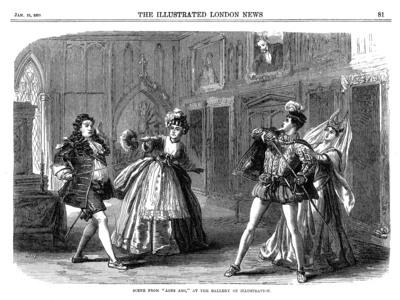Royal Gallery of Illustration

The Royal Gallery of Illustration was a performance venue located at 14 Regent Street near Waterloo Place in London, in what had been the home of John Nash, designer of Regent Street, Regent's Park, and other urban improvements undertaken at the commission of George IV.
From 1855 to about 1876, it hosted the entertainments produced by Thomas German-Reed and his wife, Priscilla, a theatrical couple who specialized in brief, humorous musical sketches and impersonations aimed at a "respectable" middle- to upper-class audience. It was also home to a wide variety of other entertainments, including numerous moving panoramas, dioramas, and lectures.
The Gallery was an intimate 500-seat theatre and, according to contemporary accounts, was "one of the most popular and fashionable places of recreation in the Metropolis." The address is now the site of an office tower.
Description of the entertainments
Under the German-Reeds, the entertainments presented at the Gallery usually consisted of one or two brief comic operas designed for a small number of characters (due to the small size of the Gallery's stage). These eventually became "Mr. And Mrs. German Reeds Entertainments". They called the establishment, euphemistically, the "Gallery of Illustration," rather than a theatre, and the pieces were called "entertainments" or "illustrations", eschewing the words "music hall", "play", "extravaganza", "melodrama" or "burlesque", in order to avoid the poor reputation among the British public of musical theatres. Reed himself composed the music for many of these pieces, and often appeared in them, along with Mrs. German Reed. Reed experimented with what he called opera di camera - small chamber operas by young composers. There was nothing else like this establishment in London. The Gallery rapidly achieved popularity.

The accompaniment consisted of piano, harmonium and sometimes a harp. But the German Reeds were able to attract fine young composers such as Molloy, Clay, Sullivan and Cellier, the best scenic designers for their tiny stage, and the best young writers from Punch and Fun magazines. Their resident piano entertainers, John Orlando Parry and Richard Corney Grain also contributed many sketches and entertainments. At first, the entertainments utilized a cast of three, but by the mid-1860s, they had expanded to pieces with a cast of four. Often the pieces' plots involved mistaken identities and disguises. In addition to Mr. and Mrs. German Reed, Fanny Holland appeared in scores of the entertainments beginning in 1869 as did Arthur Cecil and in 1871, Corney Grain. Annie Sinclair was also a frequent player at the Gallery.
Notable productions
In 1857, the Gallery hosted a command performance before Queen Victoria and Prince Albert of Wilkie Collins and Charles Dickens's play The Frozen Deep. The earliest German Reed entertainments there included William Brough's A Month from Home and My Unfinished Opera (1857); The Pyramid by Shirley Brooks (1864); The Peculiar Family by Brough (1865); The Yachting Cruise by F. C. Burnand (1866); Our Quiet Chateau by Robert Reece, with music by Virginia Gabriel (1867); Inquire Within by Burnand and John Orlando Parry (1868);[1] Beggar My Neighbour (1870) and Number 204, by Burnand; Near Relations (1871) by Arthur Sketchley;[1] King Christmas (1871, the first appearance by the German Reeds' son, Alfred); Charity Begins at Home (1872); My Aunt's Secret (1872); Very Catching (1872); Milord's Well (1873);[2]
The Gallery was also home to some of the most popular early productions of W. S. Gilbert, including No Cards (1869), Ages Ago (1869), Our Island Home (1870), A Sensation Novel (1871), and Happy Arcadia (1872). The Reeds also mounted the first professional production of Arthur Sullivan and F. C. Burnand's Cox and Box (1867) and commissioned a second opera from the pair, The Contrabandista (1867). Alfred Cellier and Arthur Cecil's Dora's Dream premiered in 1873.
Notes
References
- Adams, William Davenport. A Dictionary of the Drama, Chatto & Windus, 1904
- Lee Jackson's Victorian London page on the Gallery of Illustration
- Stedman, Jane, ed. (1967). Gilbert Before Sullivan. Chicago: University of Chicago Press.
- Williamson, David, ed. (1895). The German Reeds and Corney Grain; records and reminiscences. London: A.D. Innes.
External links
- Information about the Gallery of Illustration
- Encyclopedia entry about the Gallery's entertainments
- Description of an "Illustrative Gathering"
- Description of Horton and John Orlando Parry
- Information and links about Gilbert's works for the Gallery
- Information about Fanny Holland, who performed in scores of entertainments at the gallery
Coordinates: 51°30′32″N 0°08′02″W / 51.5089°N 0.1339°W